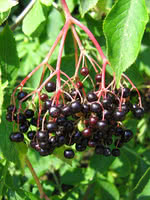Mon-Fri 9am - 5pm Mountain time
Black Elderberry vs Majestic Magenta Phlox
Sambucus canadensis
Phlox Majestic Magenta
NOT AVAILABLE THIS SEASON - MIGHT RETURN
NOT AVAILABLE THIS SEASON - MIGHT RETURN
Black Elderberry is a deciduous shrub native to eastern North America. You can plant this shrub in moist areas and it will help stabilize your soil. You can also use it on rural properties anywhere you'd use a lilac.
Black Elderberries are considered to be partially self-pollinating. So while they will still produce some berries without cross-pollination, planting with another variety will increase yields. Consider planting with Ranch Elderberry or Bob Gordon Elderberry.
Warning: the seeds, stems, leaves, roots, and uncooked berries of the Black Elderberry are poisonous to humans when eaten in quantity. You should cook the berries to make them safe for human consumption.
The Majestic Magenta is a compact ground cover plant that blooms with small, rich magenta flowers in early to mid spring. In spring expect an abundance of these star-shaped flowers.
The Majestic Magenta attracts the attention of birds and butterflies and this plant is popular for it’s low maintenance and salt-tolerance.
Black Elderberry Quick Facts
Majestic Magenta Phlox Quick Facts
Toxicity: leaves, stems, and uncooked berries are poisonous to humans

